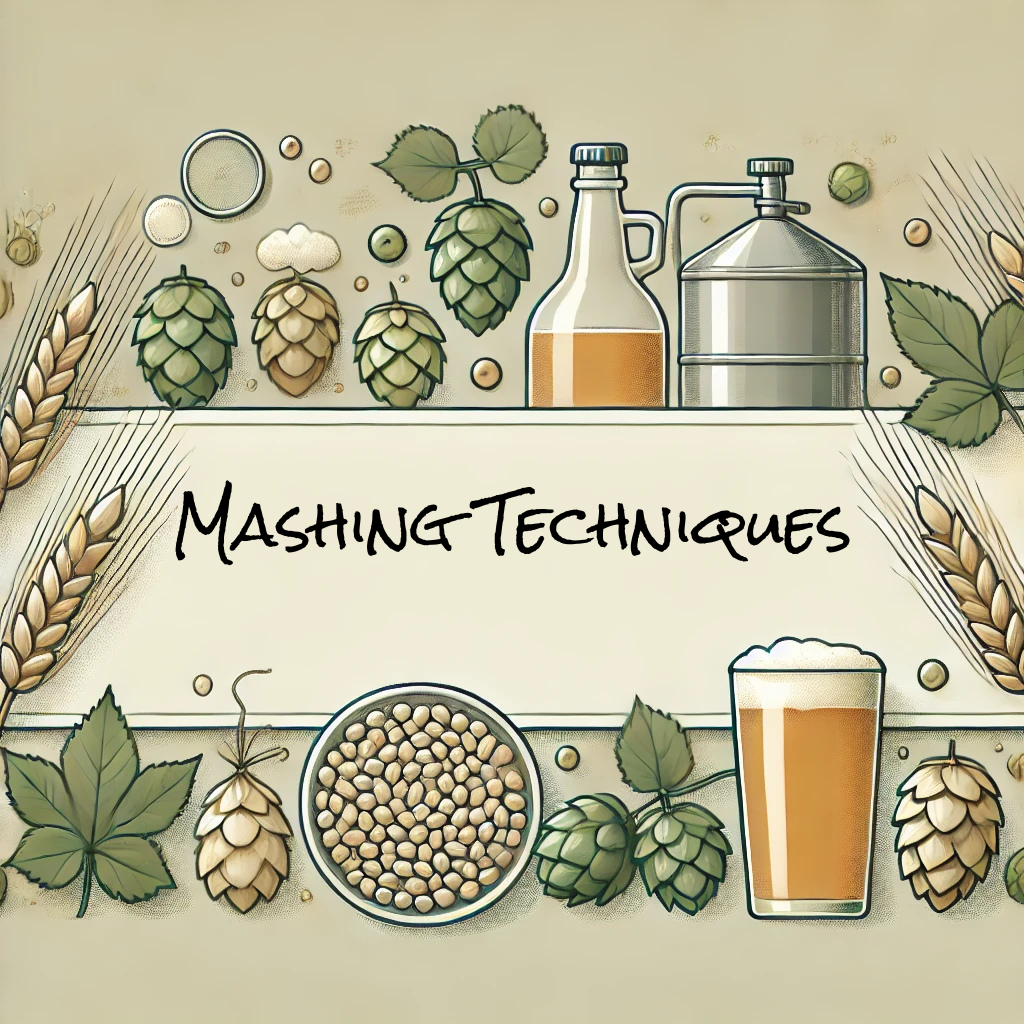
ビールの味を決める!マッシング技法徹底ガイド
さまざまな糖化(マッシング)技法の紹介
糖化(マッシング)は、ビール醸造において極めて重要なプロセスです。麦芽に含まれるデンプンを酵母が発酵可能な糖に変換する工程であり、ビールのボディ、発酵度、最終的な味わいを左右します。ここでは、代表的なマッシング技法について詳しく解説します。
シングルインフュージョン・マッシュ
日本の多くのブルワリーでも採用されている、最も一般的でシンプルな方法です。
一定温度(通常は65~68℃)で麦汁を保持
デコクションやステップマッシュと比べ設備が簡易
アメリカンエールやペールエールなど、酵素活性が高い麦芽に向いている
インフュージョンマッシュ計算式
インフュージョンマッシュで目的のマッシュ温度に達するために必要なお湯の温度を計算するための基本式:
T_water = ((T_target - T_grain) × (0.41 × W_grain + V_water)) ÷ V_water + T_target
T_water: 注入するお湯の温度(℃)
T_target: 目的のマッシュ温度(℃)
T_grain: 麦芽の初期温度(℃)
W_grain: 麦芽の重量(kg)
V_water: 使用する湯の量(L)
この式により、加えるお湯の温度を調整してマッシュ全体を希望の温度に到達させることができます。
ステップマッシュ(段階温度糖化)
温度を段階的に上げることで、異なる酵素を活性化し、よりコントロールされた糖化を実現します。
-
仕込み温度の例:
50~55℃:プロテインレスト(たんぱく質分解)
62~64℃:β-アミラーゼ活性(より発酵度の高い麦汁)
68~70℃:α-アミラーゼ活性(マウスフィール重視)
72~75℃:マッシュアウト(酵素活性停止、糖の溶出促進)
柔らかく、かつしっかりとしたボディを持ったラガーやベルジャンビールに多用されます
※注意:この手法はマッシュタンにジャケット付き加熱機能やExternal Calandria(外部加熱装置)がないと実施は困難です。ステップマッシュを導入したい場合は、このような設備が必要になります。
デコクション・マッシュ
ドイツやチェコなどの伝統的なラガースタイルに使用される技法です。煮沸したマッシュの一部を戻すことで温度を段階的に上げます。
-
シングル、ダブル、トリプル・デコクションの3種類が存在
シングル:一度のみ煮沸したマッシュを戻す(多くのモダンな醸造で使われる)
ダブル:2回デコクションを行い、より深いモルティキャラクターを引き出す
トリプル:3回の煮沸を行う伝統的手法(ピルスナー・ウルケルなど)
特徴:麦芽の複雑な風味、深い色合い、しっかりとしたボディ
時間と労力がかかるが、唯一無二のクラシックな味わいを作ることができる
タービッドマッシュ(濁り糖化)
ランビックやワイルドエールなど、伝統的なベルギースタイルで使用される特殊な手法。
デンプンが完全に分解されないように設計されている
乳酸菌や野生酵母に栄養を残すことで、長期熟成に適した風味を醸成
通常、部分的に液体を引き抜いて鍋で煮沸し、再び戻すことで温度を調整
まとめ
| 技法名 | 温度調整 | 特徴 | 向いているスタイル |
|---|---|---|---|
| シングルインフュージョン | 一定温度 | シンプル・スピーディー | アメリカンエール、IPA |
| ステップマッシュ | 段階的加温 | 精密な糖化制御 | ラガー、ベルジャン系 |
| デコクションマッシュ | 部分煮沸加温 | モルティでクラシック | ジャーマンラガー、ピルスナー |
| タービッドマッシュ | 複雑な工程 | ワイルドで複雑な風味 | ランビック、サワー |
次回の仕込みで一味違う味わいに挑戦してみませんか?自分のビールスタイルや目指す味わいに合わせて、適切なマッシング技法を選ぶことが大切です。
Mashing Techniques Overview
Mashing is a crucial process in brewing. It converts the starches in malt into fermentable sugars that yeast can use, affecting the body, fermentability, and final flavor of the beer. Let’s take a look at some of the most common mashing methods.
Single Infusion Mash
This is the most common and simplest method, used widely in Japan.
Wort is held at a single temperature (usually 65–68°C)
Requires minimal equipment compared to other methods
Ideal for well-modified malts such as those used in American Ales and Pale Ales
Infusion Mash Temperature Equation
Here’s the basic formula used to calculate the hot water temperature needed to reach your target mash temperature:
T_water = ((T_target - T_grain) × (0.41 × W_grain + V_water)) ÷ V_water + T_target
T_water : Temperature of the water to be added (°C)
T_target : Desired mash temperature (°C)
T_grain : Initial temperature of the grain (°C)
W_grain : Weight of the grain (kg)
V_water : Volume of water already in the mash (liters)
This helps you adjust strike water temperature to achieve your target mash temp.
Step Mash
A traditional German and Czech method where part of the mash is boiled and returned to raise the temperature.
-
Three types:
Single Decoction: One boil step (used in most modern applications)
Double Decoction: Two boils for deeper malt character
Triple Decoction: Traditional three-boil method (e.g., Pilsner Urquell)
Adds rich malt flavor, deep color, and full body
Time-consuming but creates complex, classic results
Decoction Mash
Yeast Selection
Choose strains specifically engineered for high-temperature fermentation, like WHC Lab’s High Voltage yeast.Adjust Your Process
Ensure proper oxygenation and rehydration protocols, especially during the initial generation, to maximize yeast health and performance.
Turbid Mash
Used in traditional Belgian styles like Lambic and Wild Ales.
Designed to leave starches partially unconverted
Provides nutrients for lactic acid bacteria and wild yeast during aging
Typically involves pulling off liquid, boiling it, then returning it to the mash to raise the temperature
Summary Table
| Method | Temperature | Features | Ideal Styles |
| Single Infusion | Fixed temperature | Simple and efficient | American Ales, IPA |
| Step Mash | Gradual increase | Precise enzymatic control | Lagers, Belgian styles |
| Decoction Mash | Boiled increments | Malty, deep, traditional | German lagers, Pilsners |
| Turbid Mash | Complex process | Funky, wild aging potential | Lambic, Sours |
Looking to try something new in your next brew? Choose the right mashing technique based on your desired beer style and flavor profile. The right mash makes all the difference.
